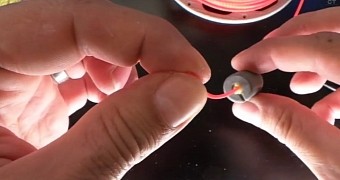FDM 3D printing technology is all well and good, but it causes fumes and certain by-products that need to be cleaned up. Some things aren't as obvious as others though, and it's them that Creative Tools wants to eliminate, or at least reduce.
Fused Deposition Modeling works by driving a filament string through a superheated extruder and depositing it on a platform little by little, drop by drop as they say.
Although, some printer heads move fast enough so that the stream of molten plastic doesn't actually get interrupted, so it's more like a flow than a drip. But we digress.
One problem that can arise is with the extruder itself if the filament isn't totally clean. Something not easy to avoid, since filament spools can't exactly be transported in sterile and dust-free environments.
The Universal Filament Filter will keep things going
Plastic melts well enough, but dust motes and the occasional grain of salt may become stuck in the extruder. Especially since the nozzle is so much narrower than the extruder itself (0.3-0.4 mm vs. 1.75 mm).
That means that, over time, enough grime can accumulate in the extruder and the filament could have trouble passing through it.
Needless to say, it can be really annoying for a print to be ruined just because filament stops coming out of the nozzle in the middle of the hours- or days-long process.
Admittedly, some of the newer 3D printers can resume a print, but even then, the resulting defect might not be easy to mask.
The Universal Filament Filter will both clean and lubricate the filament, not only eliminating the possibility of clogging (or at least reducing it by a great margin) but also by keeping it lubricated thanks to the slightest application of mineral oil.
You can find mineral oil at any convenience store, so if you add a drop or two before every other print job, you should be fine. The filter itself needs a tiny piece of foam or sponge to work. Just make sure you cut it to around the same size as the part about to be 3D printed. That way, it will last through the whole process and have enough room to hold the needed lubricant quantity.
How to install it
The filament filter doesn't need to be added to a specific part of the printer. As long as it's somewhere between the spool and the extruder, it's sufficient.
The creators of the filter, a Swedish company by the name of Creative Tools, have made the plans available for the filter itself on Thingiverse (Universal Filament Filter). The video below should act as a god enough walkthrough for its installation.

 14 DAY TRIAL //
14 DAY TRIAL // 